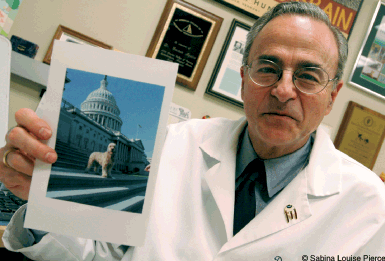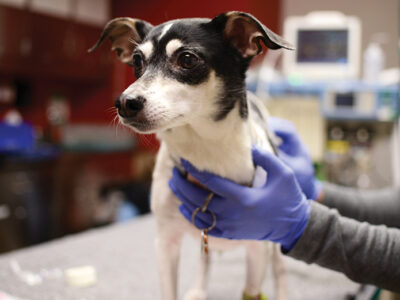
Veterinary Research | Dr. Gustavo Aguirre C’64 V’68, Gr’75 knows that seeing is believing.
So when he went to Washington several years ago to appeal to Congress for more research funding, he brought along a compelling visual aid: Lancelot, a young dog who—born totally blind—had gained eyesight after gene therapy in Aguirre’s lab.
The four-year-old briard mix became the first blind creature to acquire vision through gene therapy, which is designed to correct a genetic defect by inserting a normal copy of a gene into cells that contain the defective version. Moreover, Aguirre’s soaring success with Lancelot offers hope for curing a similar disease that blinds children at birth, Leber’s congenital amaurosis.
“This is the promise of gene therapy—making the lame walk and the blind see,” says Aguirre, professor of medical genetics and ophthalmology at the School of Veterinary Medicine, where he recently returned after a 12-year stint at Cornell’s James A. Baker Institute for Animal Health.
In his testimony that spring day of 2001, Aguirre asked lawmakers to note Lancelot’s body language—how the dog had positioned himself with his right side to the crowd (only his right eye had been treated and was visual), and how he attentively eyed whomever was speaking at the podium.
It was clear to all that this dog could see: Research appropriations were tendered. So were loving pats and adoption offers. “If you cured a mouse and brought it into the room,” Aguirre says, “half the people would walk out and one quarter of the people would jump onto their chairs.”
Lancelot belongs to a mixed colony of dogs maintained by Aguirre that harbor assorted ocular defects. They come from various breeds afflicted with inherited
diseases of the eye—Alaskan malamutes, Siberian huskies, Norwegian elkhounds, collies, and poodles, to name a few—but have one thing in common: Their diseases have human matches.
Aguirre has made it his life’s work not only to identify the genetic errors that cause such eye diseases in dogs, but also to pinpoint homologous regions of the human genome that can wreak similar havoc in people:
• Aguirre and his team have identified the genetic defects involved in progressive retinal atrophy (PRA), a family of blinding retinal disorders in dogs. In the case of dominantly inherited retinal degeneration in English mastiffs, they found the specific mutation involved and linked it to a corresponding chromosomal region in people with the human disease equivalent, retinitis pigmentosa (RP).
• In another study Aguirre used canine models of human RP to evaluate the safety and efficacy of cell therapy as a potential treatment in afflicted people.
• His group mapped the mutations involved in collie eye anomaly, a hereditary ocular disorder affecting the development of the outer portions of the eye, and compared it with a similar problem in people.
Born into a wealthy household in Havana, Aguirre spent much of his youth playing polo. His parents became concerned about his poor study habits and sent him to a boarding school in Pennsylvania. As his grades improved, his desire to become a horse veterinarian crystallized and he set his sights on Penn.
“I thought that the easiest way to get into vet school at 38th and Spruce was to go to college at 34th and Spruce,” he recalls.
In his veterinary studies Aguirre was drawn to the retina—a sheath of sensory cells lining the back of the orbit and conferring vision—because, he says, “it’s an approachable part of the brain.”
For Aguirre, the 1960s were a time to understand clinical disease by recording visual abnormalities using electroretinography (ERG), which he did during his clinical work in human ophthalmology at the medical school. In the 1970s, he developed his colony of dogs with ocular defects—largely through funding from the National Institutes of Health (NIH)—and studied eye pathology.
He then moved on to the cell biology and classical genetics of eye diseases, but by the late 1980s, he says, “it became clear that all NIH wanted to fund was finding genes.”
As Aguirre moved from cellular to molecular biology, he headed off for Cornell, which, he says, had a stronger foothold in the field then. While in New York, he maintained research collaborations with Penn.
Now back, Aguirre has a state-of-the-art lab for his molecular work and nearly $1.4 million in funding from NIH and the Morris Animal Foundation, among others. While developing other canine models for human eye disease and probing further into the genetic basis
of defects like RP in people, he will be doing some backpedaling to research the biochemical arsenals by which specific mutations produce disease.
Currently, a handful of human gene-therapy trials are in progress at Penn, but before Aguirre’s work can proceed to people suffering from Leber’s, his group must conduct further animal studies to investigate the safety of the gene-therapy protocol.
“Everyone would like a clinical trial to succeed and cure blindness, but of greater importance is causing no harm in people,” he says.
If all goes well in treating afflicted people, Aguirre hopes for the classical “dog helping the human helping the dog” outcome—that perhaps one day gene therapy will also be used to bring vision to blind pets.
—Joan Capuzzi Giresi C’86 V’98




